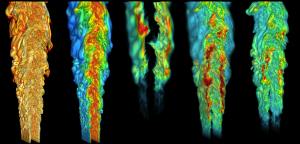Direct Numerical Simulation of Turbulence
Chemistry Interactions at High Pressure with Biofuels: Towards Predictive Models
Through co-design we will develop an exascale simulation capability tailored to combustion science. Exascale combustion simulation will be used to increase our understanding and ability to reliably predict combustion phenomena. The U.S. is at a critical crossroads where urgent issues in energy security, climate change, and economic competitiveness are converging. Aggressive national goals for reducing greenhouse gas emissions by 80 percent by 2050 will require the design of new high-efficiency low emissions combustion systems for transportation, power generation and industrial processes. Moreover, efforts to reduce our petroleum usage by 25 percent by 2020, have opened consideration to a wide and evolving set of new fuels and placed additional requirements for fuel flexibility on new combustion systems.
Combustion is a strategically important area for co-design because harnessing the power of exascale computing would lead to a transformative change in the fundamental combustion science that is studied. At present, we do not have an adequate science base for designing new combustion systems. One of the key subprocesses is associated with coupling between turbulence and chemistry in flames and ignition phenomena at the high pressure conditions characteristic of modern reciprocating and turbine engines. Today’s simulations are not able to model with sufficient fidelity to differentiate differences in flame behavior and emission characteristics between traditional, bio-derived, and other evolving fuels to provide predictive models for industrial design.
Current combustion simulation codes, running on petascale architectures, are now able to model realistic laboratory-scale flames with simple hydrogen and hydrocarbon fuels using detailed models for chemical kinetics and transport. In spite of these successes, the requirements of computing at the exascale argue that new software capabilities, designed specifically for the exascale are needed. Exascale computing will enable current combustion research to make the critical transition from simple fuels at ambient pressure laboratory conditions to complex fuels in the high-pressure environments associated with realistic engines and gas turbines for power generation. Combustion researchers will then be able to differentiate the properties of different fuels and capture their emissions characteristics at relevant thermochemical conditions. This type of capability addresses a critical need to advance the science base for the development of non-petroleum-based fuels.
While combustion research is of critical importance to the DOE, offshoots of this work also fundamentally support other high performance computing (HPC) application areas that combine computational fluid dynamics with other scientific disciplines (e.g chemistry, biology, etc.), leverages linear solvers, and supports multi-scale physics. Thus the lessons learned, the tools and analysis techniques developed in ExaCT and the fundamental results will have broad applicability to the more general HPC exascale hardware/software co-design.
For more information, please contact Dr. Jacqueline Chen of Sandia National Laboratories at [email protected].


